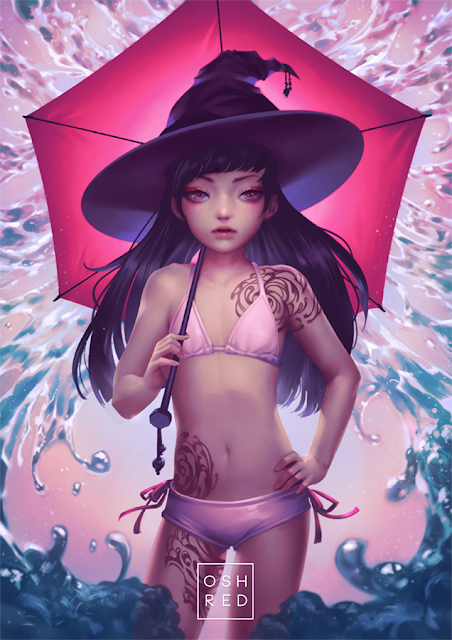The Great Train Robbery by N.C. Wyeth
N.C. Wyeth painted like a writer, he honed in on what is important to tell the story he wanted to tell at a glance so anyone could understand it. He focused in on the most exciting moment of the story and drew the viewer in to use his imagination on what happens next. Once he decided on that moment it allowed him to edit out any extraneous details to keep the drawing as simple as possible. For instance he doesn't use anything more than a simple shape of a hand and face in contrast with the strong silhouettes of the robbers and doesn't bother rendering the train or details on the clothes of the robbers anymore than he needs to.
If he had rendered more of the train the illustration would have lost focus, so instead he crops the irrelevant parts out of the picture to suggest the size of the train. The hand is more effective in showing what is going on rather than spending the time to render another person. Can you imagine what this illustration may have looked like if we saw the man with his hands up at the carriage entrance? The story then would have had to change to be about the person being robbed rather than the robbers.
Focus
The focus here is entirely on the robber with a gun. His strong silhouette shape has the most tonal variation and its clear that he is the center of our story since this detail contrasts with the complete lack of detail on the victims and the lack of detail on the man in the back.
Narrative
Whether this is the first encounter with anyone since they got on the train or they have been moving from carriage to carriage the story is clear these two men have the surprise attack on these individuals and this is communicated with the contrast of the body language of the two characters with their strong silhouettes and sense of moving forward with the simple shapes of the hand and face on the right.
They aren't carrying bags of stolen goods so they must be there for whatever it is that is in the carriage they are entering into.
Composition
N.C. Wyeth's compositions sometimes feel like landscape like shapes to me. The shape of the carriage on the left is cropped but is still left in the picture enough for it to move all the way down the image to connect with the silhouette of the man crouching in the back. A similar shape is holding your attention from going off the page on the other side and the combination of this asymmetrical composition draws all your attention to the right of the image.
The right of the image feels heavier and has the most variation in color and tone. Your eye moves along the face of the robber then down along the white of his shirt to his torso, then to the gun pointing at the victims who are simplified with a hand held in surrender and a featureless face. Your eye then finds itself resting on the shapes of the second robber's face.
The negative space shape around the figures are bold and a little bit of visual interest is added to it such as the piece of rope or fabric that hangs from both tops of the carriages.
Value
N.C. Wyeth doesn't spend time rendering anything but what he wants you to pay attention to.
The most variation in tone is on the figure on the right with several value tones used to keep your eye moving from the man in the front to the victims and back and around to the figure in the back.
The second most tonal variation is the man in the back crouching with the knife in his mouth. This is the only detail he allows for this figure outside of the details of the hand because nothing else is needed to tell the story. Less is more.
Edges
In order to make the figure fit within the bold negative space of the sky in the background we can see that he uses the white of the back drop along with the white of the shirt on the robbers right arm to blend the shapes together to where the boundaries between the two almost disappear entirely. This is called lost edges and it's used to stimulate interest by suggesting the edge your brain wants to complete the edge and has to become involved in the image to do so which keeps your readers attention.
This lost edges here are in direct contrast with the sharp edges of the rest of the piece and in only a few other instances such as the 2nd hand of the victim and the featureless face do we see soft edges.
He does variations of light to dark edges all around the robber where his back is turned to his light source and as you move down the edges are lost to the broad strokes that suggest motion.
Color
The bounce light from our source of light hitting the carriage wall and reflecting back onto the robber again keeps our attention on him and gives it another level of visual interest. The color palette looks like its mostly confined to browns oranges and yellows with the exception of a dirtier green in the pants of the robber with the gun.
Mass
The shapes of the figures and the train feel like one connected shape that extends all the way from the left of the carriage through the first silhouette, along the ground to the second silhouette and into the shadow that connects to the 2nd carriage as the enter into it.
Texture
Texture is suggested with the ragged edges along the bottom of the painting.
Links:
http://www.biography.com/people/nc-wyeth-9538189
http://muddycolors.blogspot.com/2015/04/10-things-about-edges.html
http://muddycolors.blogspot.com/2013/12/10-thingspainting-like-writer.html



Comments
Post a Comment